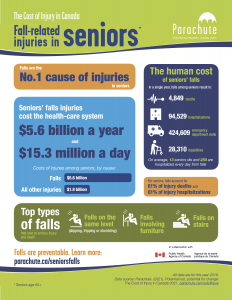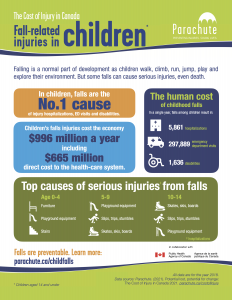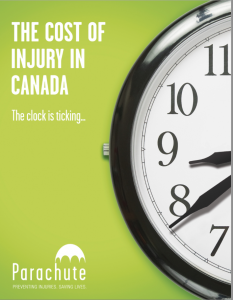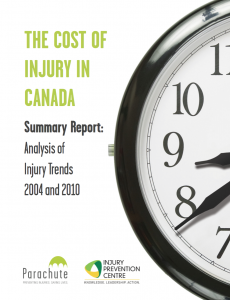This report quantifies the cost of injury from a societal perspective, including costs to the health-care system, to productivity and to the people behind the numbers: individuals, families and communities.
Parachute created The Cost of Injury in Canada 2021 in collaboration with the BC Injury Research and Prevention Unit, with support from the Public Health Agency of Canada.
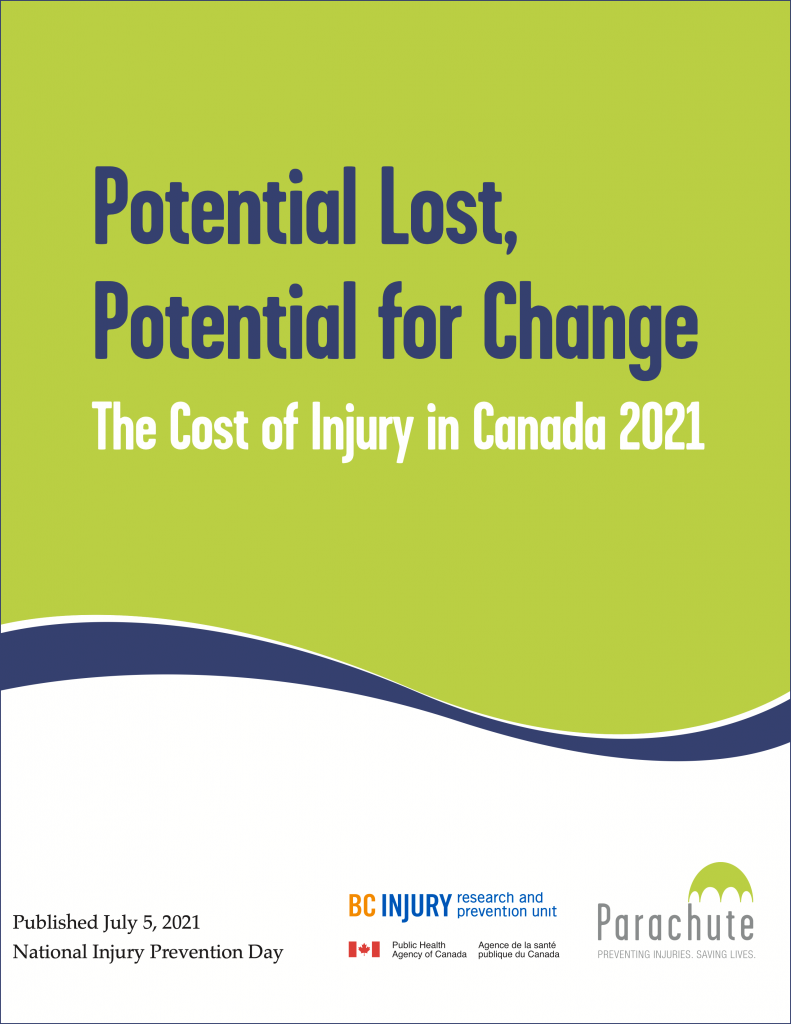
This report is the fourth of its kind. A Cost of Injury in Canada report was last published in 2015, with 2010 data. Using a similar but updated methodology, the 2021 report presents data on all injuries at the national level from the year 2018. For the first time in the report’s history, the report is published online only, featuring interactive data visualizations.
To tell the story of the cost of injury in Canada, this report presents data in five sections:
- The human cost of injury. Cases and rates of injury in Canada, 2018
- Costs to the health system and society. Total, direct and indirect costs of injury, 2018
- Costs by cause of injury. Total, per capita and per outcome costs by cause of injury, 2018
- Injury costs across the lifespan. Costs by age and sex by cause of injury, 2018
- The highest costs: Falls and transport. Costs by age and sex for specific types of falls and transport incidents, 2018
This report presents a very conservative estimate of the cost of injury. Most importantly, it does not quantify the pain and suffering preventable injuries cause for individuals, families and communities.
Preventable injuries cost the Canadian economy $29.4 billion in a single year, including $20.4 billion in direct health-care costs. The story does not end there. The human cost of injury brings pain, suffering and diminished health and well-being to individuals and their families. It impacts our potential to live long lives to the fullest.
The results of injury in 2018
- 17,475 deaths
- 61,400 disabilities, temporarily or permanently impacting potential for economic independence
- 231,530 hospitalizations
- 4.6 million emergency department (ED) visits
- $20.4 billion in direct health-care costs
- $29.4 billion in total economic costs
The overall rate of death due to injury increased between 2010 and 2018, from 43.25 to 47.15 per 100,000 population.
Leading causes of injuries
Falls were the leading cause of injury deaths, followed by:
- suicide/self-harm
- unintentional poisoning
- transport incidents.
The story of injury in Canada is a story of potential lost
Injury is the leading cause of death for Canadians ages one to 44. The human and societal potential lost through injury is immense.
In 2018, injuries stole 333,791 years of potential life lived, of missed celebrations, milestones, family memories, and contributions through work and volunteering.
The total cost of injuries, $29.4 billion, equals a cost of $80 million to the Canadian economy every day. The total direct cost of $20.4 billion translates to an average of $56 million spent per day in the Canadian health-care system that has the potential to be allocated to other needs in the system, for example, fewer critical-care hospital beds occupied as a result of injuries.
An important note about our data
Some numbers and percentages may not add up due to rounding. There may be variations in data between this report and provincial or territorial reports. For more information, review the limitations described in the Methodology section.
The highest costs incurred, by injury type
Unintentional injuries accounted for 86 per cent of injury costs ($25.3 billion). Falls had a higher total cost than any other cause in 2018, accounting for $10.3 billion, or 35 per cent, of the total cost of injury.
Other leading injury causes by cost:
- transport incidents: $3.6 billion
- suicide/self-harm: $2.9 billion
- unintentional poisoning: $2.6 billion.
The highest costs incurred, by age
- Children (0-14): falls, $996 million
- Youth and young adults (15-24): transport incidents, $990 million
- Adults (25-64): falls, $3.0 billion
- Seniors (65+): falls, $5.6 billion
We have the potential to change the story
The fact is, almost all these injuries and deaths, and the resulting costs, could have been prevented. We must take action to create a different story of a Canada free from serious injuries and deaths.
We need to invest in advocacy to ensure that our laws, the spaces and places where we live, play, work and travel, and the products we use are all built to standards that minimize injury.
We need to invest in preventative measures that we know work to reduce or eliminate injury, and educate people about their effectiveness to ensure these are widely adopted.
And we need to invest in research to grow our evidence of what is effective so we can stem Canada’s tragic loss of potential by preventing injuries and saving lives in the years to come.

